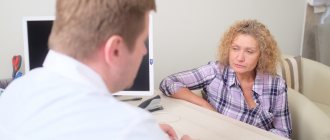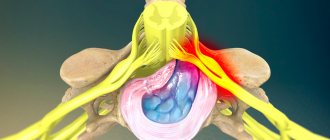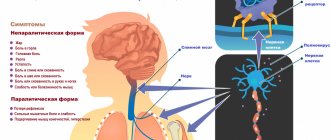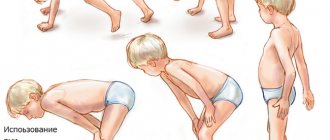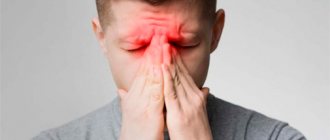If you have symptoms of thoracic neurosis, call 8(969)060-93-93 and sign up for a consultation at the Leto mental health center. Our specialists will conduct a comprehensive diagnosis, which will allow you to make the correct diagnosis and select effective treatment.
Where does chest neurosis come from?
The main cause of the disease is prolonged exposure to stress. If a person is under constant tension, his muscle tone increases. Movements become constrained. The muscles periodically spasm, which causes painful cramps. Then any sudden movement causes severe pain.
Negative symptoms persist on an ongoing basis or recur periodically. It often worsens during deep inhalation or exhalation, coughing, or when trying to perform any physical exercise. The patient's condition worsens if he has:
- Diseases of the spinal column. The problem may be associated with inflammation of the roots and joints of the spine, loss of elasticity by the intervertebral discs, etc.
- Curvature of the spine. Lordosis, kyphosis, scoliosis are diagnoses that are more often encountered by people leading a sedentary lifestyle. They slouch and make no attempt to strengthen the muscle corset of the shoulder girdle.
- History of rib fracture. The remaining deformation in the sternum area creates the prerequisites for clamps.
Among the factors complicating the course of breast neurosis:
- general hypothermia of the body;
- pneumonia;
- viral and bacterial diseases;
- pathologies of cardiovascular activity;
- oncological neoplasms in the mammary gland in women;
- diseases of the stomach and intestines.
It will not be possible to heal by eliminating only the physical component of the disease. It is imperative to stabilize the patient’s emotional background. Otherwise, a relapse of the disease will not be long in coming.
Reasons for appearance
The pain may occur intermittently. Sometimes it is a regular spasm, and in some cases it is attacks of pain. Also, unpleasant feelings can begin during inhalation and exhalation, sudden body movements, such as coughing or sneezing. Doctors distinguish between primary and secondary causes of intercostal neuralgia.
Primary:
- problems with the spine. This may be loss of elasticity of the intervertebral discs, infection or inflammation in the roots and joints of the vertebra;
- incorrect posture. Also one of the primary reasons, it occurs in most people who lead an inactive lifestyle, constantly sit in one position, and slouch;
- rib fractures. This includes deformation of the thoracic region, its pathology or tumor.
Secondary causes include:
- hypothermia of the human body;
- long periods of sitting in drafts;
- infectious diseases associated with the lungs: pneumonia, tracheobronchitis;
- heart disease: myocardial infarction, ischemia, dissecting aortic aneurysm;
- problems with the mammary glands in women, such as swelling or inflammation;
- improper functioning of the gastrointestinal tract. For example, peptic ulcer, pancreatitis.
But the main and most common cause of intercostal neurosis is stress. People who are constantly stressed experience stiffness in their movements and muscle spasms. That is why any sudden movement causes pain and can provoke intercostal neuralgia.
Types of pathology
Taking into account the location of the painful area, neurosis is classified into:
- left-handed;
- right-sided;
- bilateral.
The first option is found in medical practice more often than others. When faced with it, people often begin to think that their heart is “naughty.” Therefore, it is important not to delay visiting the doctor. Only differential diagnosis will make it possible to understand the characteristics of unpleasant symptoms and the nature of its origin.
With a right-sided disorder, it is easier to make a correct diagnosis - the doctor and the patient do not have associations with cardiovascular diseases. Therefore, the doctor can immediately assume muscle tension.
The bilateral form is the most painful. The pain has a girdling character and is excruciating. It is necessary to start treatment urgently.
Read also
Gliomas
What is a glioma?
Glioma is a neuroepithelial tumor, a type of tumor of the central nervous system, the source of growth of which is glial tissue. In turn, glial tissue (glia)… Read more
Senestopathies
Senestopathies are various painful sensations that are almost always difficult to describe by patients, originating from various areas of the body, internal organs, and which cannot be explained...
More details
Aphasia
Aphasias are speech defects that appear with minor brain damage, most often affecting the left hemisphere in right-handed people, and consisting of various forms of speech changes. Location and size...
More details
Facial paralysis (Bell's palsy/facial neuritis)
Facial paralysis is spontaneous weakness of ½ of the face. The cause is swelling of the facial nerve, as a result of its compression inside the temporal bone or in the outlet from it. Most often this leads to...
More details
Myasthenia gravis
MYASTHENIAS – a disease associated with a disruption of the immune system, as a result of which antibodies are produced against the body’s own tissues involved in the transmission of nerve impulses, which...
More details
How it manifests itself
Signs characteristic of the disorder:
- uncontrolled muscle contractions in the chest area;
- severe pain between the ribs on the right, left or both sides at once;
- discomfort in the lower back, between the shoulder blades;
- numbness of the chest, a strange sensation of “goosebumps”.
When palpated, the pain intensifies. It also becomes more pronounced when sneezing, laughing, coughing, or making sudden movements. If the patient takes painkillers, his condition will hardly improve.
Why does chest neurosis need to be treated?
The disease can have various complications. The earlier therapy is started, the lower the risk of their manifestation. Among the most common consequences of untreated breast neurosis:
- Chronic pain in the ribs and back. It deprives a person of the opportunity to lead an active lifestyle, move, play sports, dance. There is a decrease in quality of life. In some cases, advanced pathology leads to loss of ability to work.
- The range of motion in the shoulder girdle is sharply reduced. A person constantly suffers due to stiffness and muscle weakness.
- Lung diseases - bronchitis, pneumonia, obstruction - become frequent. Respiratory arrest, which can lead to death, is also possible.
- Intervertebral hernias form. This is a common complication of curvature of the spinal column, osteochondrosis. Therefore, people with thoracic neurosis who are diagnosed with these diseases should be very attentive to their health.
Examination and diagnosis
If there is discomfort in the chest, the patient is examined by a neurologist. Since the symptoms may be related to the stress experienced, a psychiatrist is involved in the work. The patient is interviewed and examined. Specialists:
- palpate the hypochondrium to determine trigger points;
- study the nature of the pain;
- exclude the presence of other diseases with similar symptoms;
- carry out CT or MRI of the chest, radiography, EEG and other instrumental examinations (as indicated).
Based on the diagnostics performed, a diagnosis is made.
Real diagnosis
Intercostal neuropathy (this is the correct name of the pathology) is a lesion of the nerves that run in the muscle tissue between the ribs. This manifests itself as a sharp, burning pain in the chest, which can also affect the upper abdomen and back. During an attack, it is difficult for the patient to move, and the pain intensifies when coughing, laughing, or even taking a deep breath. As a rule, numbness is felt along the affected nerve.
The symptoms of intercostal neuropathy are unpleasant. However, the list of reasons why this disease occurs is short:
- injuries or complications after chest surgery;
- herpes zoster or other viral infections.
Despite the fact that chest pain is one of the most common symptoms, it is obvious that intercostal neuropathy is difficult to classify as a widespread disease.
Who to contact for chest pain
First of all, it must be emphasized: the manifestation of pain in the chest requires immediate consultation with a doctor. And this doctor is by no means a neurologist. The first thing the patient needs to do is visit a therapist; in acute conditions, call an ambulance. The fact is that chest pain can indicate diseases that are much more dangerous than neurological disorders: pathologies of the cardiovascular system and lungs, oncology... So first you should make sure that the heart, lungs, gastrointestinal tract and others are not related to chest pain internal organs - and only then go to a neurologist.
Cost of services
| CONSULTATIONS OF SPECIALISTS | |
| Initial consultation with a psychiatrist (60 min.) | 6,000 rub. |
| Repeated consultation | 5,000 rub. |
| Consultation with a psychiatrist-narcologist (60 min.) | 5,000 rub. |
| Consultation with a psychologist | 3,500 rub. |
| Consultation with Gromova E.V. (50 minutes) | 12,000 rub. |
| PSYCHOTHERAPY | |
| Psychotherapy (session) | 7,000 rub. |
| Psychotherapy (5 sessions) | 30,000 rub. |
| Psychotherapy (10 sessions) | 60,000 rub. |
| Group psychotherapy (3-7 people) | 3,500 rub. |
| Psychotherapy session with E.V. Gromova (50 minutes) | 12,000 rub. |
This list does not contain all prices for services provided by our clinic. The full price list can be found on the “Prices” , or by calling: 8(969)060-93-93. Initial consultation is FREE!
Treatment of neuroses
Neurosis, the treatment of which must be immediate and include a complex of means to combat the psychotic state, must be diagnosed by a neurologist, psychiatrist, or even a regular therapist.
Treatment of neurasthenia or neurosis should include the mandatory prescription of physiotherapy methods, which helps restore sleep and mood, relieve anxiety and cause the production of happiness hormones.
Many people ask the question: “How to treat neurosis?”
The answer is quite simple - the main thing is where to treat neurosis, we offer new methods for treating psychotic disorders, which are based on the use of physiotherapy methods.
Treatment of sternal neurosis at the Leto clinic
What procedures the therapy will include depends on the stage of the disease and the dominant symptoms. As a rule, the treatment course is aimed at:
- relieving muscle spasms;
- pain relief;
- improvement of the patient’s mental state and emotional background;
- increasing overall physical activity;
- stimulation of blood circulation.
Relieving muscle tension caused by severe nervous shock includes:
- Taking non-steroidal anti-inflammatory drugs. If they prove ineffective, a blockade is carried out. It does not eliminate the root cause of the disease, but it allows a person to be relieved of severe pain for several days.
- Steroid injections. They are used only in extreme cases, for example, if neurological symptoms are accompanied by radiculopathy.
- Physiotherapy. Good results can be obtained by ultraphonophoresis, magnetic and microwave therapy, UHF, and darsonvalization. Physiotherapy makes it possible to reduce the dose of medications used and speed up the day of recovery.
- Exercise therapy. Performing physical exercises is aimed at correcting muscle tension, improving local blood circulation, and relieving existing spasms. Particular attention is paid to stretching the back.
- Vitamin therapy. Patients are shown B vitamins and ascorbic acid. They provide support to nerve fibers and have a positive effect on the functioning of the immune system and the central nervous system.
- Massage sessions. During them, the doctor works on the chest, cervical region, and shoulder girdle. The emphasis is on relaxing cramped muscles, which ensures improvement in the client's condition.
Since the root cause of the disease is stress, observation by a psychotherapist is mandatory. The doctor helps eliminate nervous tension and overcome difficulties that arise. For this purpose, she uses individual psychotherapy sessions, cognitive-behavioral practices, trainings, relaxation sessions, etc.
We treat breast neurosis comprehensively, paying attention not only to relieving symptoms, but also to eliminating the cause and preventing complications. If you are interested in a complete recovery and no longer want to endure cramping chest pain, call - 8(969)060-93-93 . We know how to help you.
Treatment of the disease
Only doctors, based on diagnostics and a comprehensive examination of the body, can make the correct conclusion - chest neurosis. Treatment methods differ depending on the course of the disease. They mean relieving pain and spasms, strengthening the nervous system, and improving blood circulation. There are several ways to treat intercostal neurosis:
- Blockade. It does not eliminate the main cause of neurosis, but this method allows you to relieve pain for several days. A blockade is done when non-steroidal anti-inflammatory drugs do not help.
- Injections. They are used only in extreme cases. For example, for radiculopathy, spinal pathologies and myelopathy, steroid injections are prescribed.
- Physiotherapy. It also relieves pain symptoms due to chest neurosis. This category includes electrophoresis, UHF and other thermal procedures. Doctors prescribe such treatment methods for incarceration, arthropathy and spondyloarthrosis.
- Training. To prevent and treat the disease, doctors recommend physical exercise. Among them are hyperextension, which serves to strengthen the back muscles, and stretching to relieve tension.
- Massage. This method helps relax muscles and also helps relieve pain. Massage is prescribed for the initial stage of intercostal neurosis, osteochondrosis, displacement of the vertebrae and spinal discs, as a preventive measure or as a method of treatment in combination with medications.
- Taking medications. B vitamins and ascorbic acid nourish nerve fibers with useful elements and strengthen the immune and nervous systems.
At the first sensation of pain, it is recommended to go to the doctor. This will allow you to prescribe timely treatment and eliminate the disease at the initial stage. Contacting a specialist will help you completely get rid of the disease. Save your health with I.G. Gernet is a psychotherapist with 20 years of experience!
To the list of articles
Other articles
- Throat neurosis: symptoms, treatment
- How to relieve a panic attack at home?
